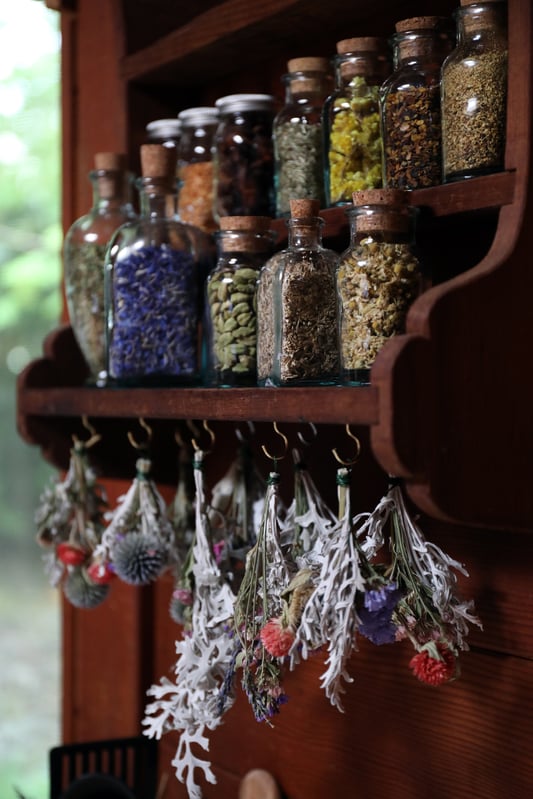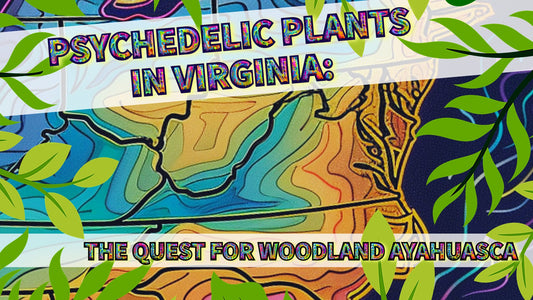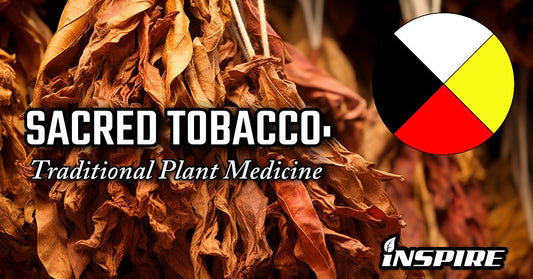Written By: Zach Champ
Connect with me on LinkedIn & Instagram!
(Originally published on American Gypsy Herbalist & Medium)

THE FIRST AMERICAN FRONTIER:
The Appalachian Mountains were the first frontier of the United States of America. This vast expanse of hills stretches from Georgia all the way to Canada.
The mountains seem to stretch out forever, with ridges and valleys repeating infinitely only to open up to the bosom of the American heartland.
Towns only pop up every so often in Appalachia, with residents living on private family farms and other land holdings tucked away mountain hollers’.


In the spring and summer, the color green greets you from everywhere as you look at the many mountaintops covered in all types of trees and the stretching fields of the river valleys below.
In Appalachia life is abundant, even in the dead of winter. You will always see various types of wildlife from deer to the common squirrel to all types of beautiful birds. You will see people going about their business and hard at work on various endeavors.
This is a region filled with a rich cultural history, and powerful energy emanates from the very rocks of the soil and mountains itself!

The Appalachians have always been inhabited by native groups of people like the great Cherokee nation.
During the colonial period, the Scot-Irish traveled from their native homes overseas and tried to settle and establish a new community for themselves here in the hills.
These European immigrants found themselves facing off and contesting with the Native American peoples who had called the area home for thousands of years prior.
The resulting history and interaction of these two cultures have helped shaped Appalachian culture and given this culture its distinct flavor and tradition that intrigues visitors today.


Both groups had to endure hardships while settling and living here within this wilderness.
The pioneers roughed out an existence as subsistence farmers, working with rocky mountain soil that was not suitable for their style of agriculture.
The native Cherokee had to deal with the political and social reality of a new ethnic group moving into their ancestral lands and pushing them out.
It was a tumultuous time, filled with uncertainty, but the settlers and natives were both persistent and determined to thrive, creating an indomitable spirit that stands to this day...
It is this will and work ethic which has come to define Appalachia over the generations!

NATURE TEACHES, PROVIDES, AND NOURISHES:
Both the European settlers and the Native Americans had knowledge on how to use the natural resources around them for a variety of purposes.
They knew how to use the land around them to create and fashion material goods, to grow food, and to heal and remedy disease.
The use of animals and plants for medicine was a common practice, and unlike modern healthcare, herbal medicine was easily available and accessible.

Medicine men and healers were essential components of the Cherokee society and helped promote cohesion and unity with the people and the natural world around them.
The Native American healer was very familiar with their surrounding environment and would be entrusted with the sacred and secret knowledge.
These healers would know where the rarest and most precious plants grew, how to mix different types of plants carefully, and could distinguish between poisonous and edible flora.

The importance of Native knowledge and understanding of medicinal plants and their various uses was ESSENTIAL for the survival of settlers in the New World.
Without this cultural exchange and sharing of knowledge, the European settlers who came to this land from overseas, would have been miserably unprepared for the challenges of living in the Appalachian hills and forests.
Both Native American and European traditional medicine relied on superstitious and spiritual beliefs as part of their healing benefits and effects.
Often cures and remedies would feature strange rituals that were intended to heal the body, but had no direct medicinal action or benefit.
A good example of these superstitious remedies includes a traditional remedy for warts which involved finding a specific type of twig or stick and carving a notch for each wart in the wood.
The settlers brought with them these old-world practices, including old pagan traditions about the secrets of using herbal remedies and recipes.
This knowledge was usually passed down from generation to generation, usually along matriarchal lines.
This was the basis for the Old Wise Woman and Healer of Appalachian culture, the so-called ‘granny witch’.

Wise women were essential members of early colonial society and provided a variety of services for community members including healing and serving as midwives.
Their knowledge of herbal medicine was widely cherished and appreciated.
Today, Appalachian folk medicine lives on as people rely on the same remedies that their grandparents and great-grandparents used to endure and survive the rugged mountains and farming lifestyle.

A DIVERSE ECOLOGY:
The reason the Appalachian Mountain region has so many different medicinal and edible plants is because it is home to one of the most bio-diverse ecosystems in the world.
In fact, many different types of climates and sub-environments exist within this vast region spanning almost the entire length of the eastern half of North America.
Biodiversity is so rich because the Appalachian region has remained geographically and ecologically unchanged for millions of years. There are many rare species in this region.
The Appalachian Mountains have more species of trees than anywhere else in Northern America. In these hills, you will find various kinds of forests with trees of all types including walnuts, oaks, hickory, birch, and evergreens like spruce and pine.
The Appalachian Mountains have many native plants that you may already be familiar with. Popular herbs such as Sassafras, Yarrow, Ginseng, Wild Ginger, and Passionflower all come from this rich and sustaining ecological area.
There are also several species here that are rare and unique that remain relatively unknown to most. This includes plants like the wildflower Foxglove, the colorful flowering tree Witch Hazel, and the peculiar Mayapple.
In the mountains, hollows, and valleys of Appalachia, there is much wildlife throughout the year.
Different types of birds ranging from delightful songbirds to impressive birds of prey are found throughout this area. Familiars like Hawk, Raven, and Eagle are regulars in the local woods or river. Beautiful blue herons and red robins, and all other varieties of colorful birds can be seen.
Animals like Beaver, Groundhog, Chipmunk, and Squirrel are present as well as White-tailed Deer, Fox, Black-Bear, Raccoon and even smelly Skunks!
The presence of so much wildlife is a testament to the relatively pure ecological condition of the land in comparison to other areas of the country.
Yet don’t be misled or deceived! Appalachia has constantly throughout its history been infiltrated and abused by corporations and their interests, often resulting in the pilfering and damaging of the land to extract precious natural resources.
We must remain vigilant to maintain the environment of Appalachia so all these animals and plants can continue to survive, thrive, and nourish our future generations.

THE LEGACY OF APPALACHIAN HERBAL MEDICINE TODAY:
Today, the tradition and heritage of herbal medicine are still active and strong within Appalachia. Herbal medicine in Appalachia is now a huge market and industry.
It is common to find an herbalist or a small shop that carries dried herbal remedies, teas, extracts, and oils. Most mothers and grandmothers are familiar with a variety of home remedies and herbal cures for common domestic ailments, carrying the torch of a discipline of knowledge that has existed in the region for hundreds of years.

Medicinal plants are extremely important to the local culture and economy of Appalachia. Many families rely on the foraging of these plants to provide medicine and food for themselves, as well as to sell as a source of additional income. These plants and the people’s relationships with them represent a long-held tradition that closely binds the residents of Appalachia to the land and mountains.
If proper measures to ensure the continuity of Appalachia’s valuable ecosystems are not in place, then these people can become at risk of losing their way of life.
This is why it’s critically important that sustainable use land practices become established as law in the region and enforced, especially in regards to ensuring the continued economic development and productivity of the region as a whole.




(They have been doing this shit for over a 100 years... and wonder why there are such huge problems in the region)
If the land is not protected than the environment will be left to the whim and mercy of foreign greedy corporations which do not represent the best interest of the people of Appalachia.
Consider this example… The Appalachian Mountain region is home to an assortment of rare plant species. Many of these plants are medicinal and as result pharmaceutical companies have taken a huge interest in the area.
One of the most prized Appalachian rare plants is Ginseng!
Ginseng is so valuable that it has become the subject of a controversy surrounding foreign companies attempting to purchase large amounts of the native plant for use in markets overseas.

China is a country that is specifically notorious for pursuing Appalachian Ginseng, where it is used as a core part of traditional-Chinese-medicine (TCM).
These companies have made local use and access to Ginseng difficult, and because of the high demand in Chinese markets, as well as elsewhere, Ginseng is at risk of being over-harvested in the wild.
You can read more about the issue with China, Appalachia, and Ginseng with this great article from Smithsonian Magazine!

LEARN MORE ABOUT APPALACHIAN HERBAL MEDICINE:
If you are interested in learning more about Herbal Medicine in the Appalachian Region than perhaps you should try signing up for a course with one of the regions many herbal medicine schools!
Appalachia School of Herbal Medicine in Asheville North Carolina: http://herbsheal.com/
Blue Ridge School of Herbal Medicine in Asheville North Carolina: https://blueridgeschool.org/
Chestnut School of Herbal Medicine in Weaverville North Carolina: https://chestnutherbs.com/
There’s no better way to truly experience the rich culture of Appalachia, learn about rare native plants, and increase your knowledge of herbal medicine...
Plus a visit to the mountains always makes for a great weekend getaway or summer vacation!

CONTINUED READING:
If you enjoyed learning about Appalachian Herbal Medicine and the history behind it than check out some of these great and educational articles on the subject below!
“A History of Southern Folk Medicine” by Phyllis D. Light RHhttps://www.americanherbalistsguild.com/files/journal/Southern%20Folk%20Medicine.pdf
“Appalachian Folk Medicine” by Mary Butler Stone
http://home.wlu.edu/~lubint/touchstone/AppalachianFolkMed-Stone.htm



)





